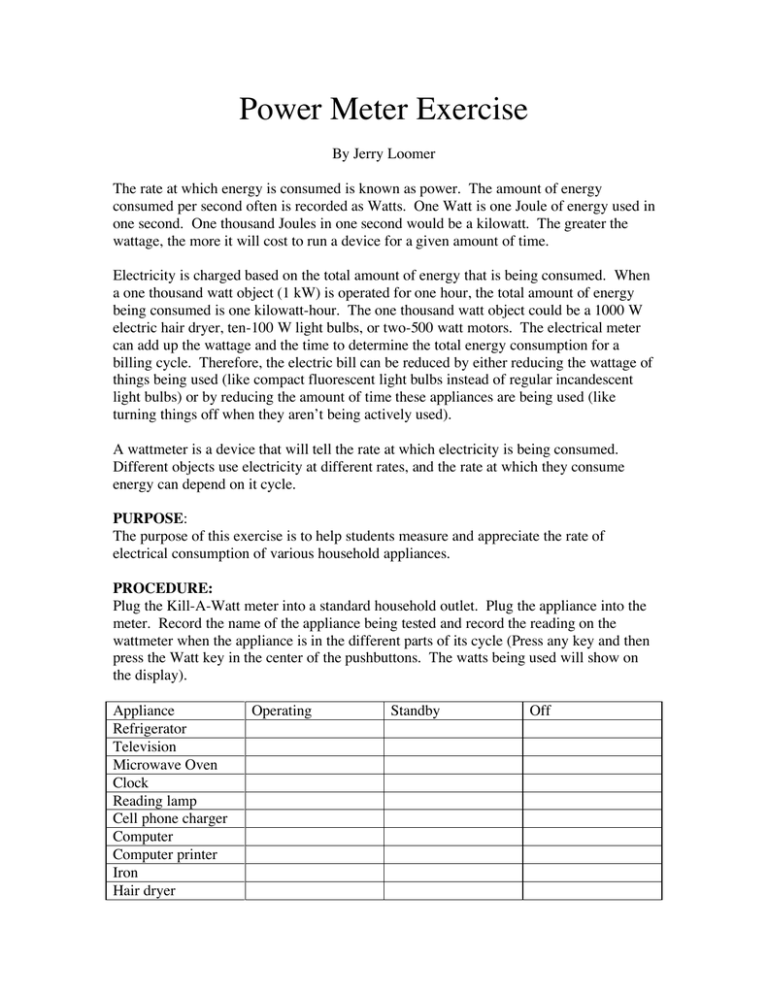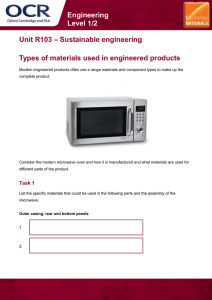Power Meter Exercise
advertisement

Power Meter Exercise By Jerry Loomer The rate at which energy is consumed is known as power. The amount of energy consumed per second often is recorded as Watts. One Watt is one Joule of energy used in one second. One thousand Joules in one second would be a kilowatt. The greater the wattage, the more it will cost to run a device for a given amount of time. Electricity is charged based on the total amount of energy that is being consumed. When a one thousand watt object (1 kW) is operated for one hour, the total amount of energy being consumed is one kilowatt-hour. The one thousand watt object could be a 1000 W electric hair dryer, ten-100 W light bulbs, or two-500 watt motors. The electrical meter can add up the wattage and the time to determine the total energy consumption for a billing cycle. Therefore, the electric bill can be reduced by either reducing the wattage of things being used (like compact fluorescent light bulbs instead of regular incandescent light bulbs) or by reducing the amount of time these appliances are being used (like turning things off when they aren’t being actively used). A wattmeter is a device that will tell the rate at which electricity is being consumed. Different objects use electricity at different rates, and the rate at which they consume energy can depend on it cycle. PURPOSE: The purpose of this exercise is to help students measure and appreciate the rate of electrical consumption of various household appliances. PROCEDURE: Plug the Kill-A-Watt meter into a standard household outlet. Plug the appliance into the meter. Record the name of the appliance being tested and record the reading on the wattmeter when the appliance is in the different parts of its cycle (Press any key and then press the Watt key in the center of the pushbuttons. The watts being used will show on the display). Appliance Refrigerator Television Microwave Oven Clock Reading lamp Cell phone charger Computer Computer printer Iron Hair dryer Operating Standby Off Other Appliances Operating Standby Off Some appliances, such as a clock, do not have a standby mode. Place an N.A. in the block to indicate that for that appliance, the reading is not applicable. Also, watch the meter while the appliance is operating and see if it fluctuates very much during your timing period. What actions take the most power? Put a word or two in the block next to the meter reading telling what was happening when the reading was taken. QUESTION: Does the power consumption of a microwave oven depend on how much is in the microwave? Place a cup of water in the microwave oven and record the maximum wattage the meter reaches while the microwave is working (Press any key and then press the Watt key in the center of the pushbuttons). Record the amount of water you have in the microwave and the Watt reading the meter gives you. Repeat this for two, three, and four cups of water. Was the consumption of the microwave the same for all four tests? If there was a difference, what caused the difference? Do you think the four cups of water would heat the same number of degrees in the same amount of time as when only one cup of water is in the microwave? QUESTION: Does the location of the item in the microwave affect the power consumption of the microwave oven? At what location will the power consumption be the greatest? Record the readings on the wattmeter when a cup of water is placed in the middle of the oven (Press any key and then press the Watt key in the center of the pushbuttons). Record the location of the water in the microwave and the Watt reading the meter gives you. Then move the water to a corner, middle side, halfway between center and side, halfway between center and corner, near the door, or other places. Record the Watt readings for all of these locations. Is the reading on the wattmeter the same or does it differ? Explain why the readings confirm or contradict your original thoughts about power consumption of microwave ovens. QUESTION: Does the power setting of the microwave affect the high reading of a wattmeter while the microwave is operating? Try setting the microwave oven for different power settings while you have the same amount of water in the same location inside the microwave oven. Record the readings of the wattmeter for many seconds. Does the wattmeter reading stay steady? Does it vary? Does it vary on a regular basis? Can you determine a relationship between the readings of the wattmeter and the power setting? QUESTION: Does an electric iron (electric hairdryer, electric curling iron, toaster, or other heating device) maintain a constant rate of power consumption or does it vary? Plug a heat-generating device into the wattmeter. Record the value given on the wattmeter for several minutes at regular intervals (say five second intervals). Appliance 0 Watts 65 Watts 5 10 15 20 25 30 35 40 45 50 55 60 70 75 80 85 90 95 100 105 110 115 120 125 Does the power stay the same? Graph the power consumption value for the different times. Why does the value change or why does it not change? QUESTION: Does your refrigerator consume electricity even when nobody is using it, like during the night? How much does it use? When you have collected data for the various appliances, zero-out the time and kilowatthours values. (zero the time and kilowatt-hours registers by unplugging the meter momentarily). Plug the meter into an outlet. Then plug the refrigerator into the wattmeter and let it go overnight. In the morning, record the total number of hours and the total energy consumption that your refrigerator registered overnight while nobody was using it. (Press the purple button on the far right side. It will give the kilowatt hours and when pressed again it will give the hours it has been collecting data.) Record these values. Divide the total kilowatt-hours by the number of hours to get the average kilowatt rate of energy consumption. Multiply it by 1000 to get the average number of watts per hour. How does this value compare with the operating rate from the previous experiment? Why are the values different? Why isn’t the vale equal to zero, nobody was putting anything in the refrigerator to make it cool down?



